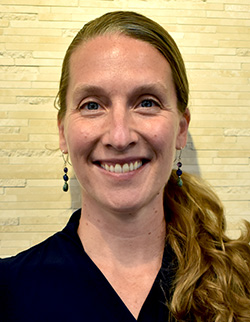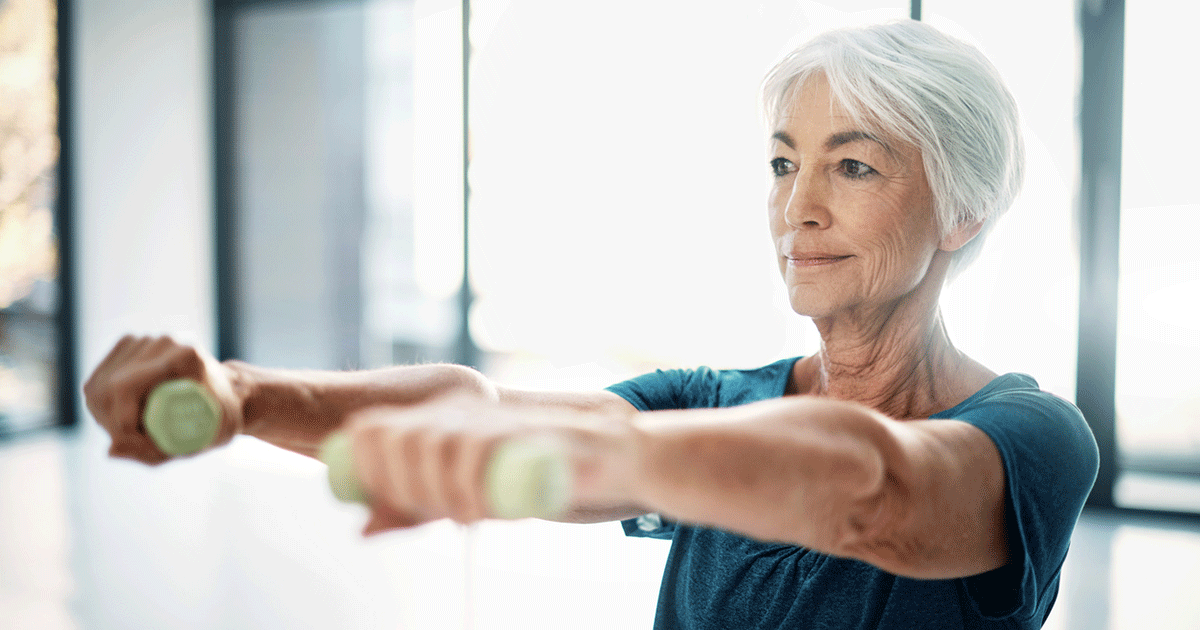Top 5 Pilates Moves for Pregnancy and Postpartum
Advice to improve your movement, fitness, and overall health from the world's #1 in orthopedics.
For a variety of reasons, it’s important to keep moving as much as possible during pregnancy. “The more you move during pregnancy, the better you’re going to feel, the stronger you’re going to be for labor and delivery, and the better your recovery will be postpartum,” says Valarie Samulski, NCPT, a certified Pilates practitioner with the Pilates Program at HSS.

While the level and type of exercise you can do might change, many forms are still safe with some adaptations. Pilates, in particular, is a great fit for expectant and new moms for much the same reasons it’s good for anybody.
“Pilates is a balanced mode of exercise that is about learning to move the body efficiently and safely in a controlled manner,” says Samulski. “It looks at how the alignment of the spine influences the way all the joints in the body work—and how to evenly distribute the effort of our muscles throughout the system.”
At its center, Pilates is about strengthening the muscles in the core to support and stabilize the body. It focuses on developing posture, balance and breathing to build body awareness—all of which can help women navigate how to move safely as their body changes over time.
Still, for safety’s sake, there are a few things to consider whatever fitness routine you choose. “Training during pregnancy is like training for a marathon. You need to do it in a really specific way,” says Samulski.
Why Modifications Matter
Even if you’ve been working out regularly for years, you’ll need to make some modifications to exercise safely. “About 75 percent of what’s taught in traditional Pilates classes isn’t at all appropriate for the pregnant or postnatal body,” says Samulski. “This could also be true for many other types of classes and workouts.”
One of the big misconceptions is that it’s okay to do what you’ve been doing until the baby starts showing. But the body begins changing during the first trimester, so your workout program needs to change then, too.
The hormone relaxin enables blood vessel walls to relax to make room for the 50% increase in blood volume that happens during pregnancy. Relaxin also loosens ligaments and tendons in the pelvis and softens the cervix for an easier labor and delivery. But since relaxin circulates throughout the body, it affects other areas, too, such as the muscles in the intestines and the tissues in the knees and ankles. Surprisingly, relaxin is at its highest point during the first trimester, so it’s important to be careful to begin modifying certain exercises like stretching starting as soon as a pregnancy is confirmed.
Dealing with Diastasis Recti
During pregnancy, the rectus abdominus (also called the six-pack abs) separates down the center line (or linea alba) to make room for the growing baby. This separation is called diastasis recti, and it’s a normal part of pregnancy.
Up to 100% of pregnant women have some level of diastasis during their pregnancy, but the degree of separation really matters most after delivery. A smaller gap may resolve on its own. But for many women, some separation remains, and it can lead to a hernia, stress incontinence (leaking urine when you laugh or cough), lower back pain and other problems. Often, an exercise program can help resolve diastasis, but if the diastasis is severe (extending to the deepest layers of muscle), it may require surgery to correct.
Exercise during and after pregnancy, if done with the proper modifications, can reduce diastasis by strengthening the other muscles of the core. If done incorrectly, however, certain moves can widen the diastasis gap.
Personalized Exercise Is Best
Samulski notes that reading one article (or 10 or 100 articles) isn’t enough to help you protect your body and your baby while exercising during and after pregnancy. There are simply too many factors—nutrition and hydration, gestational high blood pressure and diabetes, regulating body temperature in a hot or cold workout environment, and more.
That’s why it’s vital to talk to your obstetrician to get clearance before trying Pilates, or any other type of exercise, when pregnant or in the six weeks after delivery.
Samulski also suggests scheduling a one-on-one session with a certified Pilates instructor—ideally one who has taken continuing education courses focused on how to work with people who are expecting. “A certified Pilates instructor can guide you on proper form and offer other modifications throughout your pregnancy to help you stay safe,” she says.
The Pregnancy Top Five
Below, Samulski shares five Pilates moves most commonly recommended for women during and after pregnancy. “These exercises are generally safe and give you the biggest bang for your buck,” says Samulski.
1. Transversus Abdominus (TA) Contractions
The transversus abdominus is the deepest layer of the abdominal muscles. It wraps around the torso, between the ribs and hips, extending from either side of the six-pack abs (rectus abdominis) to the spine. It looks like a corset and it works like one, too, helping with posture and keeping the internal organs in place.
“During pregnancy, if you keep your transverse abdominals strong with moves like TA contractions, you can really help minimize diastasis recti,” says Samulski.
The basic move: As you exhale fully, you’ll pull your belly button in and up toward your spine. “Think of it as hugging your belly into your body,” she says. “That’s why the TA contraction exercise is often called Hug the Baby.”
2. Pelvic Floor Contractions
The pelvic floor is the foundation of the core. The pelvic floor muscles stretch around the urinary tract, vaginal and anal openings like a hammock or sling.
During pregnancy, relaxin loosens the ligaments and tendons in the pelvis, and the weight of the developing baby puts an increasing amount of pressure on the pelvic floor muscles.
Having a strong pelvic floor can make for an easier vaginal delivery and recovery, as these muscles help prevent urine leakage when you laugh or cough. “A pelvic floor that’s healthy should be strong and resilient,” says Samulski. “Doing pelvic floor contractions can help with both.”
The basic move: You’ll pretend you’re trying to stop yourself from passing gas or urine by squeezing the muscles around your vaginal and anal openings (but without squeezing the buttocks).
3. Calf Stretches
The calf muscles are among the strongest in the body. They run down the back of each leg from the bottom of the knee to the top of the ankle.
During pregnancy, changes in blood volume, hormones and posture can lead to swelling, tightness and muscle cramping in the lower legs. Moving and stretching the calves can prevent or ease these symptoms by helping “pump” blood back up toward the heart.
The basic move: Circling the ankles (clockwise and counterclockwise) or flexing and pointing the foot are some examples of simple seated calf stretches, but your Pilates instructor may also recommend some standing stretches where you lean against a wall in a lunge position to stretch the back leg.
4. Pectoral Stretches
The pectoral muscles stretch across the front of the chest, connecting to the upper arm and shoulder. Many everyday activities that make us focus forward (like typing on the computer or driving a car) can cause a forward-rounding posture.
During pregnancy (thanks to the changes to the belly and breasts) and afterward (due to carrying and possibly nursing the baby), this forward-rounded posture can be even more pronounced. In fact, it’s sometimes called mom posture.
“As this type of posture takes over, the upper back muscles can weaken and the chest muscles tighten, which can also lead to neck pain,” says Samulski. It can also make it harder to breathe deeply. Chest opening stretches and the deep breathing exercises of Pilates can help counteract these tendencies.
The basic move: Any movement that brings the shoulders up and back can stretch the pectorals (chest muscles) as well as the anterior deltoids (shoulder muscles). An assisted chest stretch using a doorway is one example of a chest opener.
5. Squatting With Support
When people think of squatting, they may imagine working the quadriceps, hamstrings, hip flexors, glutes and calves. Interestingly, squats also tone and stretch the pelvic floor, which helps prepare the body for labor and delivery, and they can even ease constipation.
“The pregnancy hormones that relax the blood vessels and connective tissue also relax the intestines, which can lead to constipation,” says Samulski. “Squats are really good for getting digestion moving.”
The basic move: When doing squats during pregnancy, it’s helpful to hold onto something to counterbalance your weight and maintain balance. There are many other nuances regarding how to position your body during squats to protect your knees and target the muscles correctly. As with the other moves discussed here, a fitness professional trained in working with pregnant populations can best guide you.
Pilates After Delivery
Delivering your baby doesn’t signal an end to your Pilates modifications. “Pilates instructors adapt exercises and teach specifically to the postpartum body for up to six months after delivery,” says Samulski.
- The first six weeks postpartum: Think of this as a recovery period. Exercising too vigorously during this timeframe can increase bleeding and slow the healing process, says Samulski. At your six-week follow-up visit, your obstetrician will let you know if you have clearance to do more. Follow their advice, and share it with your fitness team, too.
- From six weeks to six months postpartum: How your workout program evolves will depend on what your body experienced during pregnancy and delivery. How wide is your diastasis gap? Did you have a C-section or episiotomy? The good news is, there are modifications and moves to help you regain strength in the necessary places and at the pace that’s best for you.
“The most important thing about exercise before, during and after pregnancy is education,” says Samulski. “Some people tend to look at pregnant women as though they’re broken, but they aren’t. They just need the right information to exercise safely and to take care of their bodies during this really amazing and really challenging part of their lives. And we’re excited to help provide that to them.”
To schedule an individual session with a credentialed Pilates instructor through the HSS Pilates Program, call 646.618.7777.
Published 7/27/2023



